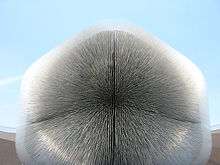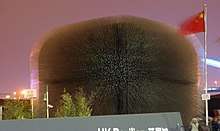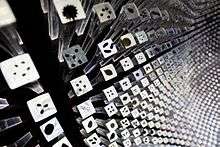UK pavilion at Expo 2010
The UK pavilion at Expo 2010, colloquially known as the Seed Cathedral, was a sculpture structure built by a nine-member conglomeration of British business and government resources directed by designer Thomas Heatherwick. It referenced the race to save seeds from round the world in banks, and housed 250,000 plant seeds at the end of 60,000 acrylic rods projecting from the walls of the building.


The structure stood where it was built, at a cost of £25 million, in Shanghai for the 2010 World Expo[1][2] and won the BIE gold award for best pavilion design.[3]
The UK Pavilion catered to over 100 public and private sector events, hundreds of VIP and dignitary visits and over seven million general public visitors during the 6 months of Expo.
The cathedral has now been dismantled, with some rods donated to schools, some donated to the World Expo Museum and some being auctioned for charity.[4]
Design

The cathedral's architecture was an elaboration of Heatherwick's 2003 work of the Sitooterie II in Essex, United Kingdom. The initial design strategy for the UK Pavilion established three aims to meet the Foreign Commonwealth Office's key expectation that the pavilion should become one of the five most popular attractions at the Expo, but built using half the budget of other Western nations. The first aim was to design a pavilion whose architecture was a direct manifestation of what it was exhibiting. The second idea was to ensure a significant area of open public space around it so visitors could relax and choose either to enter the pavilion building, or see it clearly from a calm, non-queuing vantage point. And thirdly, it would be unique among the hundreds of other competing pavilions, events and programmes.
The studio developed the idea of the UK Pavilion exploring the relationship between nature and cities. From here came Heatherwick’s idea of involving Kew Gardens' Millennium Seed Bank Partnership whose mission is to collect the seeds of 25% of the world’s plant species by 2020.The design process evolved to produce two interlinked and experiential elements: an architecturally iconic Seed Cathedral, and a multi-layered landscape treatment of the 6,000m2 site.[5]
The Seed Cathedral consisted of over 60,000 25-foot acrylic optic fibers. It housed 60,000 plant seeds at the end of acrylic rods, held in place by geometrically-cut holes with the rods inserted therein.[6]
See also
![]()
References
- "Inside World Expo 'Seed Cathedral'". BBC News. 9 March 2010.
- http://www.treehugger.com/files/2010/04/awe-inspiring-seed-cathedral-shanghai-world-expo-2010.php
- "BIE Day at EXPO 2010". Retrieved 1 November 2011.
- Pavilion seeds sold in a wink through online auction
- Jordana, Sebastian. "UK Pavilion for Shanghai World Expo 2010 / Heatherwick Studio". ArchDaily. Retrieved 3 May 2010.
- "UK Pavilion at Shanghai Expo 2010 by Thomas Heatherwick". Dezeen. Retrieved 4 April 2010.
External links
Architecture Critic Edward Lifson interviews architect Thomas Heatherwick in Shanghai about his Seed Cathedral.